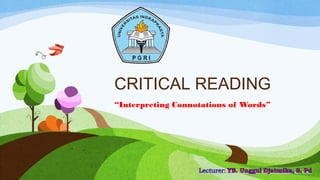
Interpreting Connotations of Words
- 1. CRITICAL READING “Interpreting Connotations of Words”
- 5. What is Denotation? • Denotation is an explicit or literal defitinion that can be found in any dictionary. • What a word denotes is its objective meaning.
- 6. Example of Denotation What this picture denotes is a flower with a sweet smell that grows on a bush with thorns on it stems. We call it a Rose.
- 7. What is Connotation? • Connotation is subjective cultural or emotional association that some word or phrase carries. • What a word connotes is the ideas and associations it suggests.
- 8. Example of Connotation The word ‘baby’ literally means a very young child. In this picture Spongebob uses ‘baby’ connotatively to show his endearment and affection.
- 9. Types of Connotations • Positive Connotation is words that make people feel good. • Negative Connotation is words that provoke a negative emotional response. • Neutral Connotation means not good or bad; indifferent; used when the author doesn’t want to show strong emotions either way.
- 10. Examples of Types of Connotations Positive Neutral Negative That’s a glamorous necklace. That’s a nice necklace. That’s a gaudy necklace. Alex is a little one. Alex is a child. Alex is a brat.
- 11. The Function of Connotations • To make a persuasive and convincing writing. • To make the author’s ideas acceptable and believeable. • To influence the readers’ thinking.
- 12. Which one is the best aprroach if you want to change your friend’s opinion? How do you feel about this one? And how about this?
- 13. Which one is the best book review that makes the reader want to buy it? What do you think about this one? And what about this? • The White Hotel by D.M Thomas is a highly imaginative novel; reading it, I entered into a dream world, filled with the most extraordinary and unique fantasies. • The White Hotel by D.M Thomas is a highly unrealistic novel; reading it, I entered into a dream world, filled with the most extraordinary and eccentric fantasies.
- 14. The use of connotative words is not always supertitious or bad. Poets, novelists, and dramatists also make positive use of connotations. Their intention is not only deceive the reader but to make them ‘see’, ‘hear’, and ‘feel’ through words.
- 15. Tone and Mood Two very important aspects of writing that are normally implied rather than stated.
- 16. What is Tone? • Tone is like a tone of voice • It reflects the author’s attitude toward his or her subject and sometimes towards his or her readers. • Tone can provide a clue to an author’s purpose.
- 17. Kinds of Tone • Objective or subjective tone • Optimistic or pessimistic tone • Humorous tone • Ironic tone • etc
- 18. The following paragraphs illustrate different tones. • Anas Urbaningrum is everything a statesperson should be. An eloquent speaker, he has ability to choose the right words at the right moment. Filled with determination as he is. He will undoubtedly be elected president. • Anas Urbaningrum is a true politician. A smooth talker, he knows just what to say and when to say it. Devour with ambition as he is. He will undoubtedly be elected president.
- 19. What is Mood? • Mood is the feeling that a text produces in the reader. • Mood produced by a text can be happy, admiring, enthusiastic, dissaproving, angry, etc. • Mood can tell you something about the circumstances surrounding the topic.
- 20. Can you identify the mood of these paragraphs? Members of the union leadership met yesterday with management to debate what they called the “union-busting tactics” of their employers. When a representative of management spoke, she was greeted with a prolonged silence that ended in catcalls and whistles. On the part of of the workers. Clearly, the audience was not please with her proposals. When the meeting ended, union and management left in stony silence.
- 21. Summary • Denotation is an explicit or literal defitinion. • Connotation is subjective cultural or emotional association. • Paying attention to connotations of words is particularly important in helping you understand what is not explicitly stated in the text, especially tone and mood that is implied on the text.
- 22. Thank you for your attention. Group B Critical Reading
- 23. Let’s have a look at this video!...
- 24. “Interpreting Connotations of Words” (this presentation is an excerpt of Chapter 3 of “Critical Reading”, an internal publication of Unindra)
